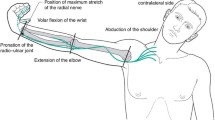Abstract
We explored the performance of a glenohumeral TMR (targeted muscle reinnervation) patient in controlling the activity of two reinnervated muscles of the chest and back during a compensatory tracking task that implied quick switches of activity between the two muscles. The same task was conducted in intact-bodied subjects, using either the wrist flexor/extensor muscles (innervated by the nerves were used as donors in the TMR patient) or the chest/back muscles that were re-innervated in the patient following the TMR. As expected, the intact-bodied subjects showed better control performance when using the wrist muscles than when using the chest and back muscles. Using the reinnervated chest and back muscles, the TMR patient performed similarly in the compensatory task than the able-bodied subjects when they used wrist muscles and his performance was superior than that of the able-bodied subjects using their chest and back muscles for control. These results indicate that the control properties have been improved through TMR.
Access this chapter
Tax calculation will be finalised at checkout
Purchases are for personal use only
Similar content being viewed by others
References
T.A. Kuiken, The scientific basis of targeted muscle reinnervation, in Targeted Muscle Reinnervation: A Neural Interface for Artificial Limbs: 9 (2013)
D. Farina et al., Noninvasive, accurate assessment of the behavior of representative populations of motor units in targeted reinnervated muscles. IEEE TNSRE 22(4), 810–819 (2014)
D.T. McRuer, E.S. Krendel, The human operator as a servo system element. J. Franklin Inst. 267(5), 381–403 (1959)
T. Kapelner et al., Motor unit characteristics after targeted muscle reinnervation. PLoS ONE 11(2), 1–12 (2016)
Acknowledgments
This work is financially supported by the European Commission and Research Council through the projects INPUT and DEMOVE, Grant Agreement No: 687795 and 267888.
Author information
Authors and Affiliations
Corresponding author
Editor information
Editors and Affiliations
Rights and permissions
Copyright information
© 2017 Springer International Publishing AG
About this paper
Cite this paper
Schweisfurth, M.A. et al. (2017). TMR Improves Performance of Compensatory Tracking Using Myoelectric Control. In: Ibáñez, J., González-Vargas, J., Azorín, J., Akay, M., Pons, J. (eds) Converging Clinical and Engineering Research on Neurorehabilitation II. Biosystems & Biorobotics, vol 15. Springer, Cham. https://doi.org/10.1007/978-3-319-46669-9_109
Download citation
DOI: https://doi.org/10.1007/978-3-319-46669-9_109
Published:
Publisher Name: Springer, Cham
Print ISBN: 978-3-319-46668-2
Online ISBN: 978-3-319-46669-9
eBook Packages: EngineeringEngineering (R0)




